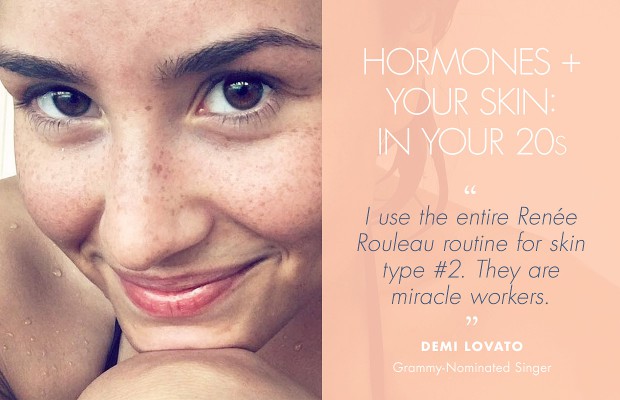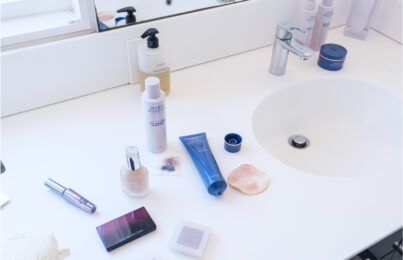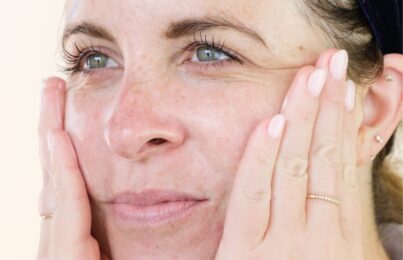Updated 3/20/19. Intrinsic aging is determined by heredity, your genetic programming that controls the hormones responsible for how your skin and body will look and feel. The skin will behave differently under the influences of these hormones, but how exactly do they affect skin from ages 20-30?
- How is the skin affected by hormones during your ages 20-30?
- Tips for getting clear and healthy-looking skin in your 20s
- De-stress and get plenty of sleep
- Go easy on anti-aging products
- Consult with your doctor to experiment with different types of birth control options
- Use a skin brightener to fade brown spots occurring from birth control pills or pregnancy-induced melasma
- Do your research before getting an IUD
- For a deeper dive into your hormone-related concerns, consult with an endocrinologist
- Load up on topical skin hydrators to keep skin looking fresh
- Choose acne spot treatments for the type of breakouts you get
- Wash with a gentle, antibacterial cleanser to prevent monthly hormonal breakouts
- Focus on preventing, instead of reacting to your “that time of the month” breakouts
- Limit sugary carbohydrate foods in your diet
- Limit dairy in your diet if you’re prone to cystic breakouts
Particularly in the early to mid-twenties (ages 22-25), hormones from the teenage years should start to level out and breakouts should be less. However, fluctuations in hormone levels right before and during a young woman’s period can stimulate sebaceous glands to produce excess oil resulting in monthly breakouts. This is what we call adult hormonal acne. It can be very frustrating for many who expect their breakout years to be behind them only to find out that this is not really the case—especially during that time of the month.
In your late 20s, growth hormones will start to slow down so some things will start to calm down (yay!) but this is when you’ll start to notice fine lines developing around the eyes.
As an esthetician and someone who works with a lot of people in their 20s to help get their skin looking its best, I have a lot of experience with this. The good news is there are definitely actions you can take to improve all that is going on, I promise! It just will take some effort but now is a great time to start.
How is the skin affected by hormones during your ages 20-30?
- Progesterone (regulates sleep, immunity and brain function)
- Estrogen (supports collagen production which is responsible for keeping the skin plump and free of wrinkles)
- Testosterone (regulates oil glands and hair growth)
- DHEA (protects against oxidative stress which is an important function in preventative skin aging)
- Human growth hormone (supports skin’s elasticity and muscle)
During your previous teen decade, your hormones were acting on your sebaceous (oil) glands. The skin produced more oil and the type of breakout that you had back then was probably more like pustules (red, inflamed blemishes that come to a whitehead). Adult acne for those in their 20s can appear quite different. You’ll tend to get smaller, less inflamed clogged pores and blackheads, as well as painful, deep cystic bumps that can often appear under the chin and jawline.
Most breakouts in your 20s are still hormone-related but now they tend to fluctuate around your monthly cycle or be triggered by other hormone-triggering influences. (Stress, lack of sleep. More on that later.)
Also, since many in their twenties take birth control pills (and have been for many years now), this may have an impact on breakouts if you decide to go off of them. It’s important to know that when you are on the pill, it regulates the hormone levels and your body has never been exposed to your natural hormone activity. Discontinuing the pill might bring your body back to what it would naturally be and you might find yourself dealing with breakouts for the first time in a long time.
Aside from hormonal breakouts, the skin should generally act much calmer than it did in your teen years, but dehydration is more prevalent because of increased progesterone levels affecting water retention.
Tips for getting clear and healthy-looking skin in your 20s
De-stress and get plenty of sleep
It is now widely accepted that stress can cause almost any illness or disorder to be worse. In some cases, stress may totally trigger a biological issue. Many in their 20s are busy studying, working and socializing, and getting 7-8 hours of sleep a night isn’t always happening. It’s a fact that stress and therefore lack of sleep can negatively affect the skin. Stress not only affects acne flare-up, in general, but it also worsens the overall skin condition. This is because stress induces the adrenal glands into overproduction of cortisol, a steroid, which in turn makes sebaceous glands produce more oil to make skin extra oily. This sebum may cause your follicular walls to swell, making it difficult for oxygen to penetrate the follicle. Since bacteria have a hard time thriving in oxygen, the lack of it sets up the perfect environment for breakout activity. This the reason why in stressful periods, people experiencing an increase in acne will get more of the inflamed, puss-filled type of papules, rather than simple whiteheads or blackheads.
Go easy on anti-aging products
There is much awareness about preventative skin aging and many young women in their 20s are very conscious about putting in the effort earlier than later. While I certainly applaud and encourage this effort, it’s important not to overdo it in a home care regimen. Many products geared for preventing the appearance of wrinkles have potent active ingredients in them that increase the metabolism of the cells (such as certain vitamin combinations and peptides) and may be too active for a younger complexion. Since skin in the 20s is already metabolically active, the stimulation of anti-aging products could possibly increase breakouts. Especially in the 20s, it’s very important to use products only for your skin type. Read my beginner’s guide to healthy aging.
Note for retinoid users: I’m sure you have heard all about the anti-acne AND anti-wrinkle effects that retinol and prescription retinoids can offer. While this is partially true, it’s not entirely accurate. As for prescription retinoids, the type of acne that they work best for is what is known as “comedonal acne.” This is the type that appears as whiteheads, blackheads, closed comedones, and clogged non-inflamed bumps, so they technically aren’t traditional blemishes or zits. How retinoids help these non-infected bumps is by restoring the organization of cells through cellular turnover. This, in turn, prevents cells from getting trapped and blocked in the pore lining.
Retinoids do NOT work as well for sore, inflamed pustular acne or cysts. In fact, when someone has infected, pustular and cystic acne, retinoids may actually make them worse. Acne is an inflammatory disease of the skin. Therefore, it’s not a good idea to stimulate this type of acne with retinoid activity. It’s far better to use products that have more proven acne-improving benefits like salicylic acid, tea tree, beta glucan, niacinamide, manuka, sulfur, lactic acid and benzoyl peroxide. Beware of skincare salespeople or brands that claim treating acne AND wrinkles with their retinol product is a one-stop shop. This is false and anyone sharing this is simply not informed of how retinol works. Trust me on this! Read my beginner’s guide to using retinol and prescription retinoids. To reiterate, retinoids helps with non-infected clogged bumps and not with traditional infected pustular blemishes.
Consult with your doctor to experiment with different types of birth control options
If you are someone who currently takes birth control pills, particularly for a long period of time but has been experiencing an increase in your breakouts, I recommend checking with your doctor to experiment with different types. Many of my clients have found that making a change can have a positive influence for lessening acne and occasional hormonal breakouts. Some examples of FDA-approved birth control pills that seem to lessen breakouts include Ortho Tri Cyclen, Yaz, and Estrostep but your doctor can help to determine the best course of action. If you are not someone who is taking the pill, it may help due to the effect on natural hormonal balance. This is a great post that discusses the various birth control methods and how they might affect the skin.
Use a skin brightener to fade brown spots occurring from birth control pills or pregnancy-induced melasma
Brown mustache above the lip? Yep. You can thank birth control pills for this one. If you have never been pregnant and have gotten brown spots and discoloration, it could be from birth control pills. Due to the increase in estrogen, it can create, the pill can trigger melanin activity. Talk with your doctor to experiment with different dosages to manage your hormone levels.
Should you get pregnant, many young women can develop pigmentation due to the increase in hormonal activity. This is a very frustrating condition as patches of brown spots can appear most often above the lip, on the cheeks or forehead. The cause is hormonal changes (the increase of estrogen) which turns on melanin pigment production. What to do? For anyone who is pregnant, your best defense for preventing pigmentation is to start using a natural skin lightener every day under your sunscreen.
Recommended skin brightener: Vitamin C&E Treatment. This is really important to use daily under sunscreen to fade the look of discoloration and is perfectly safe to use during pregnancy. There are many types of vitamin C (ascorbic acid, alpha lipoic acid, and l-ascorbic acid are a few examples) but I have found that magnesium ascorbyl phosphate works best for fading discoloration and it’s the one I have chosen to use in my formula.
Do your research before getting an IUD
IUD’s, while a very popular form of birth control can cause acne. It is listed as a side effect of IUD’s containing progesterone, specifically Mirena and Skyla and possibly Liletta. (Birth control pills, are available in either estrogen and progestin combinations, or in just progestin by itself, whereas hormonal IUDs are progestin-only.) What happens is that the IUD releases progestin into the body and gets converted into progesterone, which then turns into various types of testosterone. There isn’t enough estrogen the body to balance all of this out. This mix of hormones will overstimulate your oil glands and when mixed with dead cells in the pore lining, can trigger acne, particularly cystic acne—the hard, painful bumps that develop deep within the skin and can linger for weeks. Generally a copper IUD is your best choice if you want an IUD and you tend to get acne, but of course, you and your doctor can discuss all of this.
For a deeper dive into your hormone-related concerns, consult with an endocrinologist
This is a special kind of physician who specializes in hormonal issues. Aside from changes in your skin, it’s normal in your 20s to have other disruptions. An endocrinologist can run all sorts of tests to provide specialized help for those who have constant hormone fluctuations.
Load up on topical skin hydrators to keep skin looking fresh
To combat dehydration in the skin that can occur in your 20s, introduce serums like which uses ingredients like sodium hyaluronate, sodium PCA and hyaluronic acid, which holds up to 1000 times its weight in water. When your skin gets really hydrated with water, skin cells get plump and the skin takes on a fresh glow. Note: There’s a BIG difference between dry skin and dehydrated skin and you really need to know what that is.
Choose acne spot treatments for the type of breakouts you get
All breakouts are not equal nor is every blemish spot treatment. For example, if you experience deep, painful cystic bumps, applying a traditional drying spot treatment will only leave the surface of the skin a flaky, dry mess while leaving the active bump underneath. It’s so important that you understand there is a life cycle for each type of blemish. I highly recommend that you read my step-by-step instructions for what to do the moment a blemish appears to get it to go away fast with minimal scarring. Please read it several times so you can truly understand how the natural healing process works. This information has been very insightful for my acne clients to help them learn why they are often making things much worse by using the wrong type of blemish at the incorrect stage of the healing process. Simply put, you always want to work in sync with Mother Nature.
Wash with a gentle, antibacterial cleanser to prevent monthly hormonal breakouts
Since the chemistry of your skin changes during your menstrual cycle, switching up your cleanser only (not your entire routine) can help head off a breakout. A perfect acne-fighting cleanser that I recommend is AHA/BHA Blemish Control Cleanser which utilizes salicylic acid and gentle non-plastic microbeads to deep clean the pores. It was actually awarded “Best Cleanser for Oily Problem Skin” by Allure Magazine. Since it’s sulfate-free, it won’t dehydrate or irritate the skin. Start about three days before your period hits, as that’s when hormones begin to change, and continue through the week.
Focus on preventing, instead of reacting to your “that time of the month” breakouts
Easier said than done. However, it’s important to know that you’re fighting a losing battle if you just focus on spot treating a blemish once it appears. Preventing them is essential and with the right types of anti-bacterial, pore-clearing products, you can definitely lessen the breakout activity due to hormones. Read more about why you’re getting monthly hormonal acne and tips to prevent it.
Limit sugary carbohydrate foods in your diet
Another key aspect of preventing hormonal breakouts may have to do with what you put in your mouth. Those sugary carbs so many young women crave during their period may be the very thing causing the breakout to occur. They can cause a prolonged increase in insulin levels and increase acne. So try cutting back on the carbs, especially prior to your period, and you may find you’ll experience less monthly blemishes.
Limit dairy in your diet if you’re prone to cystic breakouts
Since most dairy cows are given growth hormones, the consumption of milk, cheese and yogurt become factors that influence endogenous hormones and mimic the hormones that trigger oil production in the skin to ignite the acne process. Consider eliminating all dairy for two weeks to determine if this is the cause of your cystic breakout activity.
Read how hormones affect the skin in the teens, 30s, 40s, 50s and 60s.
Celebrity Esthetician & Skincare Expert
As an esthetician trained in cosmetic chemistry, Renée Rouleau has spent 35 years researching skin, educating her audience, and building an award-winning line of products. Her hands-on experience as an esthetician and trusted skin care expert has created a real-world solution — products that are formulated for nine different types of skin so your face will get exactly what it needs to look and feel its best. Trusted by celebrities, editors, bloggers, and skincare obsessives around the globe, her vast real-world knowledge and constant research are why Marie Claire calls her “the most passionate skin practitioner we know.”



